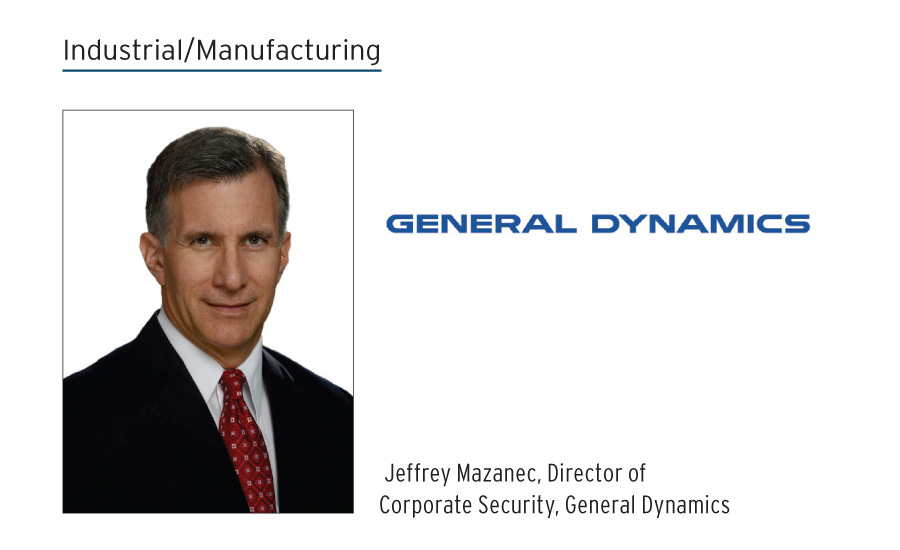General Dynamics, one of the nation’s top five defense contractors, “is a global aerospace and defense company,” says Jeffrey Mazanec, Director of Corporate Security. “We are organized by four business groups: Marine Systems, Combat Systems, Aerospace, and Information Systems and Technology.”
The security team “is involved in securing General Dynamics’ people, assets and competitive advantage as we do three things: identify, prioritize and mitigate the most important global risks,” says Mazanec. “We do that by aligning with our business operations, leveraging our resources, and building effective partnerships.”
Mazanec finds working in his sector thrilling. “We support our military’s ability to do everything from fighting to logistics to communication to sharing,” he says. “From a security vantage point, that makes the job exciting each and every day as we partner with both industry and government to accomplish that mission.”
One of the specific challenges Mazanec sees is “a continually evolving global environment that requires an intense focus on changing risk, aggressive and hostile actors, and espionage,” he says. Also, there is a “leveling of the playing field as cyber intrusions put propriety information at greater risk and an increasing threat of terrorism in light of the growing Lone Actor phenomenon.”
Although security risks change constantly, Mazanec is focused on protecting proprietary information and keeping employees safe. “We’re always attempting to increase company awareness of the threat of terrorism, which can occur both inside and outside the workplace,” he says. “Part of this comes as training and pushing needed information to employees.”
Keeping current with the state of the world and potential threats is another area of focus, as is conducting risk analysis for the organization. “The business in which General Dynamics is engaged cannot stop and so the security services need to adapt and stay relevant,” says Mazanec. “Often that requires creativity and reinventing the traditional role or recommendations. We’re obviously very focused on compliance with the federal regulations that govern the Defense Industrial Base. As we seek compliance, we also strive to identify risk and move resources to the most important risks.”
Measuring the value of security in the organization involves the degree of integration security has with General Dynamics’ stakeholders. “We constantly examine how closely we are aligned to the business objectives of our company,” Mazanec says. “If business leadership sees value, they will continue to ask for input and invite us into the business process. If we are isolated, our value quotient is small and we have little impact. We have to maintain ‘agility’ in the same way that the business side must be agile.”
Other measurements of security’s value include keeping tabs on “how well we are leveraging our resources throughout the business units” and “how well we are building and utilizing partnerships in the industry and throughout government and the public sector,” says Mazanec. “A continued dialog of sharing and partnering benefits everyone, including the security impact of my team.”
The security team is also mindful of being efficient with their resources and focuses on constantly improving. “We must constantly be of the mindset that we may not be as good as we need to be, but we’re better than we were last month. Our security practices must be more agile and efficient than the last try, and this is how we measure value to both the customer and the company,” Mazanec says.
Mazanec’s team is “very engaged with the C-suite and provides risk intelligence to maintain organizational threat awareness,” he says. “We also work very closely with our peers in the Defense Industrial Base, since we share the same risks and issues. We work closely to benchmark our services and share best practices when it comes to things like building new facilities, sharing threat information, or developing tighter and more efficient ways to comply with federal regulations and identify risk within our industry.”
The most difficult part of the job is “moving in so many directions every day all at the same time, and at the same time, trying to remain lean and have a small footprint,” says Mazanec. “Being nimble and flexible to move to whatever sub-program or discipline that’s required at the moment is a real challenge.”
In the off hours, Mazanec likes to do physical activities outdoors. “Hiking, biking with my family, getting exercise, staying in shape. That, I think, allows me to come back the next day or the next week and do this fairly stressful job.”
Security Scorecard
Annual Revenue: $31 billion
Security Budget: Confidential
Critical Issues
-
Employee and Executive Travel
-
Protection of Proprietary and Classified Information
-
Risk Management






